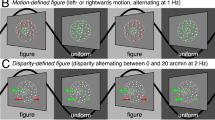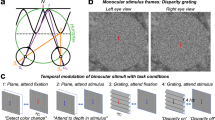Summary
The lateral geniculate body performs a spatial remapping operation. This remapping may help to preserve the apparent distance of objects under symmetrical eye movements, thereby stabilizing the appearance of visual space. In addition, a related, and perhaps more basic function of the geniculate remapping may be to increase the efficiency of the neural matrix which encodes depth information. For distant fixation, the majority of cells in this cortical matrix would be responsive to crossed disparities, but for near fixation, many of these same cells might be converted into “uncrossed disparity detectors”. Two types of models for the geniculate are presented, together with supporting evidence: (1) a quantitative psychophysical model describing its steady-state properties, and (2) a qualitative neurophysiological model describing the function of the geniculate laminae.
Similar content being viewed by others
References
Aubert, H., u. R. Förster: Untersuchungenüber Raumsinn der Retina. Albrecht v. Graefes Arch. Ophthal. 3, Chap. 2, 1–37 (1857).
Bappert, J.: Neue Untersuchungen zum Problem des Verhältnisses von Akkommodation und Konvergenz zur Wahrnehmung der Tiefe. Z. Psychol. 90, 167–203 (1922).
Barlow, H., C. Blakemore, and J. D. Pettigrew: Possible neural mechanisms of binocular sterepsis. J. opt. Soc. Amer. 57, 572 (1967) (Abstract).
Bishop, P. O.: The neurology of visual direction. Presented at an M. I. T. Psychology Department Colloquium, Cambridge, October 1963.
Bizzi, E.: Changes in orthodromic and antidromic response of optic tract during the eye movements of sleep. J. Neurophysiol. 29, 861–870 (1966a).
— Discharge patterns of single geniculate neurons during the rapid eye movements of sleep. J. Neurophysiol. 29, 1087–1095 (1966b).
Blank, A. A.: The Luneburg theory of binocular visual space. J. opt. Soc. Amer. 43, 717 (1953).
Chacko, L. W.: A preliminary study of the distribution of cell size in the lateral geniculate body. J. Anat. (Lond.) 83, 254–266 (1949).
Epstein, W., J. Park, and A. Casey: The current status of the size-distance hypothesis. Psychol. Bull. 58, 491–514 (1961).
Evarts, E. V.: Methods for recording activity of individual neurons in moving animals. Meth. med. Res. 11, 241–250 (1966).
Foley, J. M.: Binocular disparity and perceived relative distance: An examination of two hypotheses. Vision Res. 7, 655–670 (1967).
Freeman, E.: Anomalies of visual acuity in relation to stimulus distance. J. opt. Soc. Amer. 22, 285–292 (1932a).
— Accommodation, pupillary width, and stimulus distance. J. opt. Soc. Amer. 22, 729–734 (1932b).
Graham, G. H.: Vision and visual perception. New York: John Wiley & Sons 1965.
Held, R.: (Chairman): Symposium on locating and identifying: Two modes of visual processing. Presented at the meeting of the Eastern Psychological Association, Boston, Mass., April 1967. Psychol. Forsch, (in press).
Helmholtz, H. v.: Treatise on physiological optics, vol. III (J. P. C. Southall, ed.). NewYork: Dover 1962.
Henneman, E., G. Somjen, and D. O. Carpenter: Functional significance of cell size in spinal motor neurons. J. Neurophysiol. 28, 560–580 (1965a).
—, G. Somjen, and D. O. Carpenter Excitability and inhibitability of motoneurons of different sizes. J. Neurophysiol. 28, 599–620 (1965b).
Hering, E.: Spatial sense and movements of the eye. Translated by C. A. Radde. Baltimore: American Academy of Optometry 1942.
Hillebrand, F.: Die Stabilität der Raumwerte auf der Netzhaut. Z. Psychol. Physiol. Sinnesorg. 5, 1–60 (1893).
— Lehre von den Gesichtsempfindungen. Wien: Springer 1929.
Holst, E. v., u. H. Mittelstaedt: Das Reafferenzprinzip. Naturwissenschaften 37, 464–476 (1950).
Jacobs, G. H.: Responses of the lateral geniculate nucleus to light increment and decrement and the encoding of brightness. Vision Res. 6, 83–87 (1966).
Jones, A. E.: Wavelength and intensity effects on the response of single lateral geniculate nucleus units in the owl monkey. J. Neurophysiol. 29, 125–138 (1966).
Kawamura, H., and P. L. Marchiafava: Modulation of transmission of optic nerve impulses in the alert cat. Brain Res. 2, 213–215 (1966).
Kuno, M.: Excitability following antidromic activation in spinal motoneurons supplying red muscles. J. Physiol. (Lond.) 149, 374–393 (1959).
Le Gros Clark, W. E., and G. G. Penman: The projection of the retina on the lateral geniculate body. Proc. roy. Soc. B 114, 291–313 (1934).
Levelt, W. J. M.: On binocular rivalry. Soesterberg Institute for Perception, RVO-TNO, 1965.
Linksz, A.: Physiology of the eye, vol. 2. Vision. New York: Grune & Stratton 1952.
Luckiesh, M., and F. K. Moss: The dependence of visual acuity upon stimulus distance. J. opt. Soc. Amer. 23, 25–29 (1933).
—, and F. K. Moss The variation in visual acuity with fixation distance. J. opt. Soc. Amer. 31, 594–595 (1941).
Luneburg, R. K.: Mathematical analysis of binocular vision. Princeton: Princeton Univ. Press 1947.
Mackay, D. M.: Towards an information-flow model of human behavior. Brit. J. Psychol. 47, 30–43 (1956).
— Interactive processes in visual perception. In: W. A. Rosenblith (ed.), Sensory communication, p. 339–355. Cambridge: M. I. T. Press 1961.
McCready jr., D. W.: The size-distance perception and accommodation-convergence micropsia a critique. Vision Res. 5, 189–206 (1965).
Miller, T. J., and K. N. Ogle: Stereoscopic localization of afterimages with eyes in asymmetric convergence. Invest. Ophthal. 3, 339–353 (1964).
Ogle, K. N.: Perception of distance and size. In: H. Davson (ed.), The eye, vol. 4, Visual optics and the optical space sense, p. 247–270. New York: Academic 1962.
— Researches in binocular vision. New York: Hafner 1964.
— Some aspects of stereoscopic depth perception. J. opt. Soc. Amer. 57, 1073–1081 (1967).
Pitts, W., and W. S. McCul-loch: How we know universals. Bull. Math. Biophysics 9, 127–147 (1947).
Polyak, S.: The vertebrate visual system. H. Klüver (ed.). Chicago: Chicago Univ. Press 1957.
Rashbass, C., and G. Westheimer: Independence of conjugate and disjunctive eye movements. J. Physiol. (Lond.) 159, 361–364 (1961).
Richards, W.: Apparent modifiability of receptive fields during accomodation and convergence and a model for size constancy. Neuropsychologia 5, 63–72 (1967a).
— Size scaling and binocular rivalry. J. opt. Soc. Amer. 57, 576 (1967b) (Abstract).
Ronchi, V.: Optics the science of vision. New York: The University Press 1957.
Schneider, G. S.: Superior colliculus and visual cortex: Contrasting behavioral effects of their ablation in the hamster. Unpublished doctoral diss. M. I. T., 1966.
Shipley, T.: Convergence function in binocular visual space. I. Anote on theory. J. opt. Soc. Amer. 47, 795–803 (1957).
Sperry, R. W.: Neural basis of the spontaneous optokinetic response produced by inverted vision. J. comp. physiol. Psychol. 43, 482–489 (1950).
Teuber, H.-L.: Perception. In: J. Field (ed.), Handbook of physiology, vol. III. Neurophysiology, p. 1595–1668. Baltimore: Williams & Wilkins Press 1960.
Zuber, B. L.: Physiological control of eye movements in humans. Unpublished doctoral diss., M. I. T., 1965
Author information
Authors and Affiliations
Additional information
This work was supported by the U.S. Air Force under contract No. AFORSR-F 44620-67-C0085. Supplementary funding was received from NASA and NIMH under grants Ns G 496 and MH 05673 awarded to Prof. H.-L. Teuber, Chairman, Dept. of Psychology, M. I. T., Cambridge, Mass.
Rights and permissions
About this article
Cite this article
Richards, W. Spatial remapping in the primate visual system. Kybernetik 4, 146–156 (1968). https://doi.org/10.1007/BF00288548
Received:
Issue Date:
DOI: https://doi.org/10.1007/BF00288548




